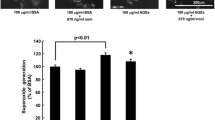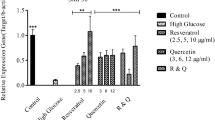Abstract
Advanced glycation endproducts (AGE) are oxidative products formed from the reaction between carbohydrates and a free amino group of proteins that are provoked by reactive species (RS). It is also known that AGE enhance the generation of RS and that the binding of AGE to a specific AGE receptor (RAGE) induces the activation of the redox-sensitive, pro-inflammatory transcription factor, nuclear factor-kappa B (NF-ĸB). In this current study, we investigated the anti-oxidative effects of short-term kaempferol supplementation on the age-related formation of AGE and the binding activity of RAGE in aged rat kidney. We further investigated the suppressive action of kaempferol against AGE's ability to stimulate activation of pro-inflammatory NF-ĸB and its molecular mechanisms. For this study, we utilized young (6 months old), old (24 months old), and kaempferol-fed (2 and 4 mg/kg/day for 10 days) old rats. In addition, for the molecular work, the rat endothelial cell line, YPEN-1 was used. The results show that AGE and RAGE were increased during aging and that these increases were blunted by kaempferol. In addition, dietary kaempferol reduced age-related increases in NF-κB activity and NF-ĸB-dependant pro-inflammatory gene activity. The most significant new finding from this study is that kaempferol supplementation prevented age-related NF-κB activation by suppressing AGE-induced nicotinamide adenine dinucleotide phosphate oxidase (NADPH oxidase). Taken together, our results demonstrated that dietary kaempferol exerts its anti-oxidative and anti-inflammatory actions by modulating the age-related NF-κB signaling cascade and its pro-inflammatory genes by suppressing AGE-induced NADPH oxidase activation. Based on these data, dietary kaempferol is proposed as a possible anti-AGE agent that may have the potential for use in anti-inflammation therapies.







Similar content being viewed by others
References
Asgary S, Naderi GA, Zadegan NS, Vakili R (2002) The inhibitory effects of pure flavonoids on in vitro protein glycosylation. J Herb Pharmacother 2:47–55
Bierhause A, Hofmann MA, Ziegler R, Nawroth PP (1988) The AGE/RAGE pathway in vascular disease and diabetes mellitus. Part І. The AGE-concept. Cadiovasc. Res. 37:586-600. Biogerontology 4:399–408
Bronska M, Czuba ZP, Krol W (2003) Effect of flavone derivatives on interleukin 1β mRNA expression and IL-1β protein synthesis in stimulated RAW 264.7 macrophages. Scand J Immunol 57:162–166
Brownlee M (1995a) Advanced protein glycosylation in diabetes and aging. Annu Rev Med 46:223–234
Brownlee M (1995b) Biochemistry and molecular cell biology of diabetic complications. Nature 6865:813–820
Bucala R, Cerami A (1992) Advanced glycosylation: chemistry, biology, and implications for diabetes and aging. Adv Pharmacol 23:1–34
Cai W, He JC, Zhu L, Peppa M, Lu C, Uribarri J, Vlassara H (2004) High levels of dietary advanced glycation end products transform low-density lipoprotein into a potent redox-sensitive mitogen-activated protein kinase stimulant in diabetic patients. Circulation 3:285–291
Corsini E, Terzoli A, Bruccoleri A, Marinovich M, Galli CL (1997) Induction of tumor necrosis factor-alpha in vivo by a skin irritant, tributyltin, through activation of transcription factors: its pharmacological modulation by anti-inflammatory drugs. J Invest Dermatol 108(6):892–896
Csiszar A, Ungvari Z, Edwards JG, Kaminski P, Wolin MS, Koller A, Kaley G (2002) Aging-induced phenotypic changes and oxidative stress impair coronary arteriolar function. Circ Res 11:1159–1166
García-Mediavilla V, Crespo I, Collado PS, Esteller A, Sánchez-Campos S, Tuñón MJ, González-Gallego J (2007) The anti-inflammatory flavones quercetin and kaempferol cause inhibition of inducible nitric oxide synthase, cyclooxygenase-2 and reactive C-protein, and down-regulation of the nuclear factor kappaB pathway in Chang Liver cells. Eur J Pharmacol 2- 3:221–229
Go EK, Jung KJ, Kim JY, Yu BP, Chung HY (2005) Betaine suppresses proinflammatory signaling during aging: the involvement of nuclear factor-kappaB via nuclear factor-inducing kinase/IkappaB kinase and mitogen-activated protein kinases. J Gerontol A Biol Sci Med Sci 60(10):1252–1264
Griendling KK, Sorescu D, Ushio-Fukai M (2000) NAD(P)H oxidase: role in cardiovascular biology and disease. Circ Res 86(5):494–501, Review
Hamilton CA, Brosnan MJ, McIntyre M, Graham D, Dominiczak AF (2001) Superoxide excess in hypertension and aging: a common cause of endothelial dysfunction. Hypertension 2 Part 2:529–534
Hatada EN, Krappmann D, Scheidereit C (2000) NF-kappaB and the innate immune response. Curr Opin Immunol 12(1):52–58, Review
Hofmann MA, Drury S, Fu C, Qu W, Taguch A, Lu Y, Avila C, Kambham N, Bierhaus A, Nawroth P, Neutath MF, Slattery T, Beach D, McClary J, Nagashimura M, Moreser J, Stern D, Schmidt AM (1996) RAGE mediates a novel pro inflammatory axis: a central cell surface receptor for S100/calgranulin polypeptides. Cell 97:889–901
Huang SM, Wu CH, Yen GC (2006) Effects of flavonoids on the expression of the pro-inflammatory response in human monocytes induced by ligation of the receptor for AGE. Mol Nutr Food Res 12:1129–1139
Jiang XH, Tu SP, Cui JT, Lin MC, Xia HH, Wong WM, Chan AO, Yuen MF, Jiang SH, Lam SK, Kung HF, Soh JW, Weinstein IB, Wong BC (2004) Antisense targeting protein kinase C alpha and beta1 inhibits gastric carcinogenesis. Cancer Res 16:5787–5794
Jung HA, Jung YJ, Yoon NY, Jeong da M, Bae HJ, Kim DW, Na DH, Choi JS (2008) Inhibitory effects of Nelumbo nucifera leaves on rat lens aldose reductase, advanced glycation endproducts formation, and oxidative stress. Food Chem Toxicol 12:3818–3826
Jung KJ, Lee EK, Kim JY, Zou Y, Sung B, Heo HS, Kim MK, Lee J, Kim ND, Yu BP, Chung HY (2009) Effect of short term calorie restriction on pro-inflammatory NF-kB and AP-1 in aged rat kidney. Inflamm Res 58(3):143–150
Kerr LD (1995) Electrophoretic mobility shift assay. Methods Enzymol 254:619–632
Kim HK, Park HR, Lee JS, Chung TS, Chung HY, Chung J (2007) Down-regulation of iNOS and TNF-alpha expression by kaempferol via NF-kappaB inactivation in aged rat gingival tissues. Biogerontology 8(4):399–408
Kim JY, Jung KJ, Choi JS, Chung HY (2006) Modulation of the age-related nuclear factor-kappaB (NF kappaB) pathway by hesperetin. Aging Cell 5(5):401–411
Kislinger T, Fu C, Huber B, Ou W, Taguchi A, Du Yan S, Hofmann M, Yan SF, Pischetsrieder M, Stern DM, Schmidt AM (1999) N(epsilon)-(carboxymethyl) lysine adducts of proteins are ligands for receptor for advanced glycation end products that activate cell signaling pathways and modulate gene expression. J Bio Chem 44:31740–31749
Labuza TP, Baisier W (1992) The role of the Federal Government in food safety. Crit Rev Food Sci Nutr 31:165–176
Lee VS, Dou J, Chen RJ, Lin RS, Lee MR, Tzen JT (2008) Massive accumulation of gallic acid and unique occurrence of myricetin, quercetin, and kaempferol in preparing old oolong tea. J Agric Food Chem 17:7950–7956
Li J, Schmidt AM (1997) Characterization and functional analysis of the promoter of RAGE, the receptor for advanced glycation end products. J Biol Chem 26:16498–16506
Li J-M, Shah AM (2001) Differential NADPH- versus NADH-dependent superoxide production by phagocyte-type endothelial cell NADPH oxidase. Cardiovasc Res 52:477–486
Liang YX, Wang Z, Li DD, Jiang JM, Shao RG (2003) Effects of aging and advanced glycation on gene expression in cerebrum and spleen of mice. Biomed Environ Sci 16:323–332
Lu C, He JC, Cai W, Liu H, Zhu L, Vlassara H (2004) Advanced glycation endproduct (AGE) receptor 1 is a negative regulator of the inflammatory response to AGE in mesangial cells. Proc Natl Acad Sci USA 32:11767–11772
Nakayama H, Mitsuhashi T, Kuwajima S, Aoki S, Kuroda Y, Itoh T, Nakagawa S (1993) Immunochemical detection of advanced glycation end products in lens crystallins from streptozocin-induced diabetic rat. Diabetes 42(2):345–350
Ramana KV, Friedrich B, Srivastava S, Bhatnagar A, Srivastava SK (2004) Activation of nuclear factor-kappaB by hyperglycemia in vascular smooth muscle cells is regulated by aldose reductase. Diabetes 11:2910–2920
Ramasamy R, Yan SF, Schmidt AM (2005) The RAGE axis and endothelial dysfunction: maladaptive roles in the diabetic vasculature and beyond. Trends Cardiovasc Med 15(7):237–43
Schleicher ED, Wagner E, Nerlich AG (1997) Increased accumulation of the glycoxidation product N(epsilon)-(carboxymethyl)lysine in human tissues in diabetes and aging. J Clin Invest 3:457–468
Schmidt AM, Yan SD, Wautier JL, Stern D (1999) Activation of receptor for advanced glycation end products: a mechanism for chronic vascular dysfunction in diabetic vasculopathy and atherosclerosis. Cir Res 84:489–497
Shi Y, Vanhoutte PM (2008) Oxidative stress and COX cause hyper-responsiveness in vascular smooth muscle of the femoral artery from diabetic rats. Br J Pharmacol 3:639–651
Slatter DA, Murray M, Bailey AJ (1998) Formation of a dihydropyridine derivative as a potential cross-link derived from malondialdehyde in physiological systems. FEBS Lett 421(3):180–184
Sumi D, Ignarro LJ (2004) Regulation of inducible nitric oxide synthase expression in advanced glycation end product-stimulated raw 264.7 cells: the role of heme oxygenase-1 and endogenous nitric oxide. Diabetes 53(7):1841–1850
Thornally PJ (1998) Cell activation by glycated proteins: AGE receptoer recognition factors and functional classification of AGE. Cell Mol Biol 44:1013–1023
Umezawa K, Chaicharoenpong C (2002) Molecular design and biological activities of NF-kappaB inhibitors. Mol Cells 4(2):163–167, Review
Umezawa K, Ariga A, Matsumoto N (2000) Naturally occurring and synthetic inhibitors of NF-kappaB functions. Anticancer Drug Des 5(4):239–244, Review
Vlassa H, Bucala R, Striker L (1994) Pathogenic effects of advanced glycosylation: biochemical, biologic, and clinical implications for diabetes and aging. Lab Invest 70:138–151
Wautier J, Guillausseau P (2003) Advanced glycation end products, their receptors and diabetic angiopathy. Diabets Metab 29(1):86–87
Wautier MP, Chappey O, Corda S, Stern DM, Schmidt AM, Wautier JL (2001) Activation of NADPH oxidase by AGE links oxidant stress to altered gene expression via RAGE. Am J Physiol Endocrinol Metab 280(5):E685–E694
Winlove CP, Parker KH, Avery NC, Bailey AJ (1996) Interactions of elastin and aorta with sugars in vitro and their effects on biochemical and physical properties. Diabetologia 39(10):1131–1139
Yamaguchi F, Ariga T, Yoshimura Y, Nakazawa H (2000) Antioxidative and anti-glycation activity of garcinol from Garcinia indica fruit rind. J Agric Food Chem 48(2):180–185
Yan SD, Chen X, Fu J, Chen M, Zhu H, Roher A, Slattery T, Zhao J, Magashima M, Morser J, Migheli A, Nawroth P, Stern D, Schmidt AM (1996) RAGE and amyloid beta peptide neurotoxicity in Alzheimer's disease. Nature 382:685–691
Acknowledgements
This work was supported by National Research Foundation of Korea (NRF) grant funded by the Korea government (MEST) (20090093226). We thank Aging Tissue Bank for providing research samples.
Author information
Authors and Affiliations
Corresponding author
About this article
Cite this article
Kim, J.M., Lee, E.K., Kim, D.H. et al. Kaempferol modulates pro-inflammatory NF-κB activation by suppressing advanced glycation endproducts-induced NADPH oxidase. AGE 32, 197–208 (2010). https://doi.org/10.1007/s11357-009-9124-1
Received:
Accepted:
Published:
Issue Date:
DOI: https://doi.org/10.1007/s11357-009-9124-1




